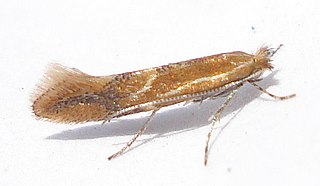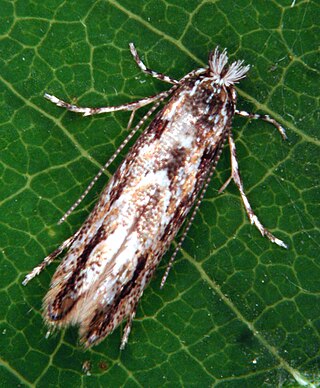
Gracillariidae is an important family of insects in the order Lepidoptera and the principal family of leaf miners that includes several economic, horticultural or recently invasive pest species such as the horse-chestnut leaf miner, Cameraria ohridella.

Phyllonorycter is a genus of moths in the family Gracillariidae.

Phyllonorycter agilella is a moth of the family Gracillariidae. It is found in Latvia central Russia, Pyrenees, Italy and Bulgaria and from France to eastern Russia.
Phyllonorycter bartolomella is a moth of the family Gracillariidae. It is endemic to the Canary Islands and is known from Gran Canaria and Tenerife.
Phyllonorycter cytisella is a moth of the family Gracillariidae. It is endemic to the Canary Islands and is known from Gran Canaria, La Palma, and Tenerife.
Phyllonorycter cytisifoliae is a moth of the family Gracillariidae. It is endemic to the Canary Islands and is known from Gran Canaria, La Palma, and Tenerife.

Phyllonorycter dubitella is a moth of the family Gracillariidae. It is found from Fennoscandia and northern Russia to the Pyrenees, Italy and Bulgaria and from Great Britain to Ukraine.

Phyllonorycter foliolosi is a moth of the family Gracillariidae. It is endemic to the Canary Islands and is known from La Palma and Tenerife.

Lithocolletinae is a subfamily of insects in the moth family Gracillariidae. It is distributed worldwide, with most species in temperate regions.

Scopula minorata is a moth of the family Geometridae. It was described by Jean Baptiste Boisduval in 1833. It is found in Africa south of the Sahara, the Arabian Peninsula and on the islands of the Indian Ocean. Furthermore, it is found in southern Europe. It can be distinguished from Scopula lactaria only by examination of its genitalia.
Phyllonorycter ruizivorus is a moth of the family Gracillariidae. It is found on La Réunion island in the Indian Ocean.
Phyllonorycter achilleus is a moth of the family Gracillariidae. It is found in the Albertine Rift and the Kakamega Forest in western Kenya. The habitat consists of tropical rainforests where Guineo-Congolian flora intermixes with savannah plants at altitudes above 1,500 meters.
Phyllonorycter grewiaephilos is a moth of the family Gracillariidae. It is found in the Rift Valley and Tsavo National Park in Kenya. The habitat consists of savannah areas at altitudes between 470 and 920 meters.
Phyllonorycter dombeyae is a moth of the family Gracillariidae. It is found in eastern South Africa in savannah intermixed with bushes and lower trees.
Phyllonorycter ipomoellus is a moth of the family Gracillariidae. It is found in south-western Rwanda in open clearings in montane wet forests at an altitude of about 1,800 meters.
Phyllonorycter hibiscola is a moth of the family Gracillariidae. It is found in western Kenya in primary Guineo-Congolian rain forest.
Phyllonorycter trochetellus is a moth of the family Gracillariidae. It is found in Mauritius.






